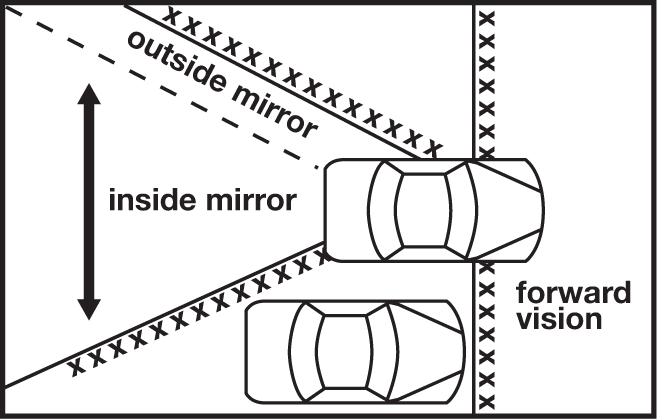Florida Driver Handbook: Blind Spots
Order now5. Driving Safety
- 5.1. Distracted Drivers
- 5.2. Getting Ready to Drive
- 5.3. Defensive Driving
- 5.4. Driving Safety for Mature Drivers - Tips to Help You Drive Safer .... Longer
- 5.5. When You Back Up
- 5.6. Avoiding Rear-end Collisions
- 5.7. Emotions
- 5.8. Basic Driver Improvement
- 5.9. Safety Belts
- 5.10. Protecting Children
- 5.11. Speed Limits
- 5.12. Following Officer's and Fireman's Instructions
- 5.13. Crossing Intersections
- 5.14. Right-of-Way
- 5.15. Stop Signs
- 5.16. Open Intersections
- 5.17. Roundabouts
- 5.18. Driveways
- 5.19. Emergency Vehicles
- 5.20. Making Turns
- 5.21. Turnabout (Three-Point Turn)
- 5.22. Turn Signals and Emergency Signals
- 5.23. Traffic Lanes
- 5.24. Blind Spots
- 5.25. Passing
- 5.26. Minimum Safe Following Distances
- 5.27. Parking
- 5.28. Expressway Driving
- 5.29. Night Driving
- 5.30. Animals
- 5.31. Reduced Visibility
- 5.32. Handling Emergencies
- 5.33. First Aid
 Blind spots are areas near the left and right rear corners of your vehicle that you cannot see in your rearview mirrors. Before you move sideways to change lanes on an expressway or to pass on any road, turn your head to make sure these areas are clear. Areas bordered by Xs are blind spots for a car with an outside mirror on the left side only.
Blind spots are areas near the left and right rear corners of your vehicle that you cannot see in your rearview mirrors. Before you move sideways to change lanes on an expressway or to pass on any road, turn your head to make sure these areas are clear. Areas bordered by Xs are blind spots for a car with an outside mirror on the left side only.
On the roads with more than one lane in each direction, do not drive in someone else's blind spot. Speed up or drop back so the other driver can see you.
Check out our Customer Reviews!


